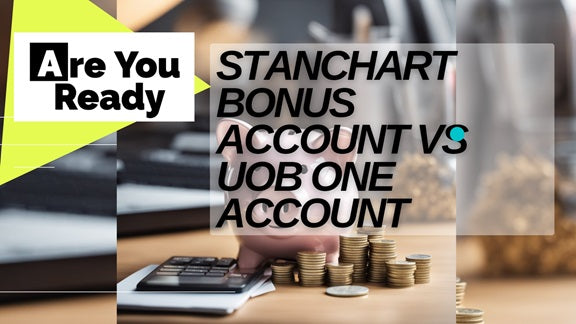When comparing savings accounts for my personal finances, it’s essential to weigh the options carefully. I recently looked into the Standard Chartered (Stanchart) Bonus$aver Account and the United Overseas Bank (UOB) One Account, both of which offer unique benefits and features that may be attractive depending on individual financial habits and goals. These accounts are tailored for residents in Singapore and are designed to incentivise savings through bonus interest rates, subject to fulfilling certain criteria.
The Stanchart Bonus$aver Account presents an innovative way to increase the amount of interest earned by linking it to certain banking activities. For instance, I can earn higher interest rates by crediting my salary, spending on their credit card, and paying bills or investing through the account. It’s structured to encourage both saving and spending through the bank’s various financial products.
On the other hand, the UOB One Account also proposes an appealing package, especially if I maintain a consistent balance and meet the minimum credit card spending requirement. Its tiered interest rate model is designed to benefit those with regular incomes and spending patterns, offering higher interest rates as a reward for consistent account usage. This could be particularly advantageous for me if I’m looking for simplicity and surety in how much interest I’ll earn each month.
Here are some of our top picks on:
Overview of Stanchart Bonus Account
In my review of the Stanchart Bonus Account, I focus on the critical aspects of eligibility, interest rates, fees, benefits, and limitations, which are essential for potential account holders to understand.
Eligibility Criteria
To open a Stanchart Bonus Account, I must be at least 18 years of age. It is designed primarily for individual account holders. I need to have a valid identification document and meet the bank’s requirements for account opening.
Interest Rates
Interest rates on the Stanchart Bonus Account are probably the highest interest rate in the market. And the more activities I conduct in my account, the higher the interest rate I can earn. For example:
- Get up to 7.88% p.a. with various activities
These rates are subject to change based on the bank’s discretion and prevailing economic conditions.
Fees and Charges
The Stanchart Bonus Account has no monthly account fee but there are certain charges that I must be aware of:
- Overdraft facility: subject to the bank’s current rates
- International transfer: fees apply per transaction
- Account closure within 6 months of opening: an administrative fee of $30 to be charged
Benefits
The benefits of holding a Stanchart Bonus Account include:
- Tiered interest rates: Potential for higher earnings with higher balances
- No monthly fee: Cost-effectiveness for maintaining the account
- Easy access: I can use online and mobile banking platforms for convenient account management.
Limitations
The limitations of the Stanchart Bonus Account are important to note:
- Minimum balance required to earn interest
- Lower interest rates compared to some fixed-term investment products
- Limited to individual account holders, which means it may not be suitable for businesses or joint accounts.
Overview of UOB One Account
I am highlighting the key aspects of the UOB One Account, focusing on its eligibility criteria, interest tiers, fees, benefits, and limitations.
Eligibility Requirements
To open a UOB One Account, I need to be at least 18 years old. Additionally, I require a minimum initial deposit of S$1,000.
Interest Rate Tiers
My balance earns interest as high as 7.8% based on the account’s tiered system:
| Account Monthly Average Balance (MAB) | Spend min. S$500 (calendar month) on eligible UOB Card | Spend min. S$500 (calendar month) on eligible UOB Card AND make 3 GIRO debit | Spend min. S$500 on eligible UOB Card AND credit your salary via GIRO |
|---|---|---|---|
| First S$30,000 | 0.65% | 2.50% | 3.85% |
| Next S$30,000 | 0.65% | 3.00% | 3.90% |
| Next S$15,000 | 0.65% | 4.00% | 4.85% |
| Next S$25,000 | 0.05% | 0.05% | 7.80% |
| Above S$100,000 | 0.05% | 0.05% | 0.05% |
Fees and Charges
- Monthly account fee: No monthly account fee
- Fall below fee: S$5, waived if I don’t maintain a minimum balance of S$1,000.
- Overdraft interest: Prevailing rates apply.
Advantages
UOB One Account offers:
- High interest potentials based on spending, credit card usage, and increments in monthly account balance.
- Convenient mobile banking with UOB’s app.
Restrictions
- To earn higher interest, I only need to meet 2 criterias such as credit card expenditure and salary crediting.
- Interest rates are subject to change according to bank policies and market conditions.
Comparative Analysis
In comparing the Standard Chartered (Stanchart) Bonus Account to the United Overseas Bank (UOB) One Account, I focus on interest rates, fees, rewards, and account management features.
Interest Rate Calculation
The Stanchart Bonus Account offers a maximum interest rate of 7.88%, where the rate increases with the number of relevant banking transactions. Customers can earn up to 4.13% p.a realistically in my opinion. Since I’ve noted that some activities such as trading or insurance are not relevant to most us folks.
The UOB One Account on the other hand employs a tiered system, rewarding users based on credit salary and the number of transactions. Interest rates realistically reach up to 5.00% p.a. for account balances of at least SGD 75,000.
Account Fees Comparison
Stanchart Bonus Account
- Fall-below fee: SGD 5 monthly (waived with minimum average balance of SGD 3,000)
- Monthly account fee: Not applicable
UOB One Account
- Fall-below fee: SGD 5 monthly (waived with minimum average balance of SGD 1,000)
- Monthly account fee: Not applicable
Rewards and Perks
The Stanchart Bonus Account provides cashback on debit card spend and offers exclusive deals for users. I’ll also mention that there are no cashback caps, which can be quite beneficial for heavy spenders.
UOB One Account customers can enjoy up to 15% cashback on eligible spending with the UOB One Card. You can get $50, $100 or $200 per quarter.
Account Management
I find both banks offer robust digital platforms for account management. Stanchart’s services include online banking and a mobile app with a user-friendly interface. These are available for both iOS and Android devices.
UOB’s suite also includes online banking alongside a mobile app, providing similar functionality. The UOB Mighty app also delivers a secure and efficient experience on both iOS and Android platforms.
Learn more: Best Cash Management Account in Singapore
Case Scenarios
In the following scenarios, I will compare the Standard Chartered Bonus$aver Account with the UOB One Account under differing financial behaviours and balances.
Low Monthly Balance
When maintaining a low monthly balance, the Standard Chartered Bonus$aver Account tends to offer a more competitive returns due to its uniform interest rate but activity reliant structure. It requires a more banking activities with the bank to unlock better rates. In contrast, the UOB One Account starts giving rewards at a higher cash balance, and customers just have to meet certain criteria such as credit card spending and salary crediting.
- Standard Chartered Bonus$aver Account: More rewarding if conditions are met.
- UOB One Account: Less favourable for low balances.
High Monthly Balance
For those with a high monthly balance, the UOB One Account becomes more appealing. It offers higher interest rates that increase with the account balance. Whereas the Standard Chartered Bonus$aver Account has a more restricted requirement for us to hit maximum interest.
- Standard Chartered Bonus$aver Account: Higher interest rates for those with lower balances.
- UOB One Account: Tiered interest, higher interest rates for larger balances.
Regular Salary Credits
With regular salary credits, both accounts provide incentives to credit your salary. The Standard Chartered Bonus$aver Account offers a bonus interest for salary credits above a specific amount. Meanwhile, the UOB One Account requires a minimum salary credit to qualify for higher interest rates but combines it with additional spending requirements.
- Standard Chartered Bonus$aver Account: Bonus interest for salary credits.
- UOB One Account: Requires salary credit plus additional criteria.
Bill Payment Facilities
When utilising bill payment facilities, the Standard Chartered Bonus$aver Account rewards customers with additional interest for paying bills through their account. The UOB One Account, on the other hand, considers bill payments as part of the qualifying transactions for higher interest rates and requires a minimum number of transactions per month.
- Standard Chartered Bonus$aver Account: Additional interest for bill payments.
- UOB One Account: Counts towards qualifying transactions.
Customer Reviews and Satisfaction
When examining the Standard Chartered (Stanchart) Bonus Account and the United Overseas Bank (UOB) One Account, I found that customers often discuss the ease of use and clarity of rewards systems of both accounts. Stanchart’s Bonus Account generally receives praise for its generous bonus interest rates, but some customers report challenges in hitting the higher tiers for bonus interest.
In contrast, UOB’s One Account offers a tiered interest system that’s favoured for its simplicity and attainability. Some customers appreciate that lower tiers offer competitive rates, which are easier to qualify for.
| Account | Positive Feedback | Negative Feedback |
|---|---|---|
| Stanchart Bonus | Accessible bonus rates at lower tiers | Requirements for maximum rates can be stringent |
| UOB One | High interest rates for upper tiers | Some dissatisfaction with customer service |
My perusal of online forums and review sites reveals that while both accounts have their advocates, there’s a clear demand for transparent criteria for earning interest. Users of the Stanchart Bonus Account commend it for the lucrative potential but advise a careful reading of the terms to maximise benefits. UOB One Account customers often express contentment with the bank’s digital app, citing it as user-friendly and a valuable tool for account management.
Furthermore, I note feedback pointing towards customer service as a pivotal area for both banks. While some customers faced challenges, others recount positive experiences with responsive and helpful staff. It’s essential to highlight that personal experiences with customer service can vary widely.
In summary, my analysis of customer reviews indicates a balance of satisfaction and preferences based on individual needs and experiences with the Stanchart Bonus and UOB One accounts.
Final Recommendations
When comparing the Standard Chartered Bonus$aver Account and the UOB One Account, my assessment is grounded on facts and the distinct features each offers. Your choice should align with your financial behaviour and saving goals. Below is a quick guide to assist in making a well-informed decision:
- Eligibility Criteria: Ensure you meet the basic eligibility requirements for the account you’re considering.
-
Interest Rates: Analyse the interest rate structures.
- The Bonus$aver offers higher potential interest, but it’s contingent on meeting more criteria.
- UOB One provides a simpler structure, which some may find more attainable.
-
Transaction Requirements:
- Standard Chartered mandates varied transaction types for optimal interest.
- UOB requires credit card spend and GIRO transactions.
Here’s a summarised comparison:
| Feature | Standard Chartered Bonus$aver | UOB One Account |
|---|---|---|
| Max Interest Rate | Lower, but consistent | Higher potential rates |
| Spending Requirement | Higher & diverse transactions | Lower & specific |
| Ease of Achieving High Interest | More challenging | Easier for those with more cash balance |
I suggest scrutinising the transaction requirements and interest tiers before deciding. If you are just starting your career, the Bonus$aver could maximise your earnings. Conversely, if you prefer simplicity and have moderate savings, the UOB One could be a better fit. Remember, personal financial habits should dictate the choice between these accounts.
Read more:

